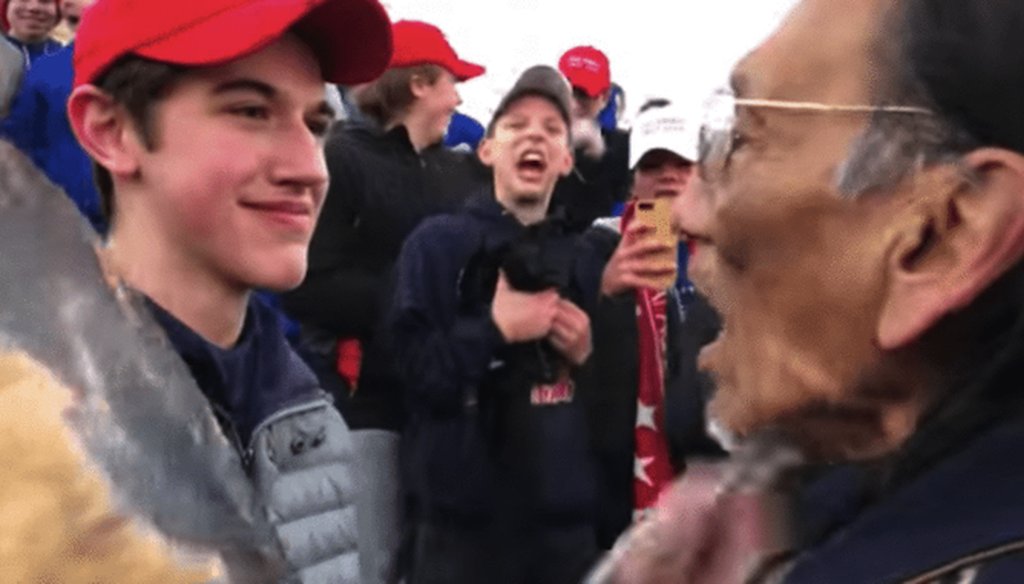Stand up for the facts!
Our only agenda is to publish the truth so you can be an informed participant in democracy.
We need your help.
I would like to contribute

Editor's note: Over Martin Luther King, Jr., weekend, a brief video clip seemed to show a teenage boy confronting a tribal elder as other teenagers egged him on. The clip went viral on social media, igniting a fiery debate over what the video actually showed. Here, senior media writer Tom Jones of The Poynter Institute explains why people had differing interpretations. Read more news about the media at Poynter.org.
What are we to believe, even when we see something with our own eyes?
As Poynter senior faculty member Al Tompkins says, "The difference between accuracy and truth is context.’’
That’s the lesson when it comes to looking at the video of the standoff between Catholic high school students and the Native American drummer in Washington, D.C., over the weekend. We all saw what we saw. A young man wearing a Make America Great Again hat standing in front of a Native American banging a drum and chanting.
But did we really see what we think we saw?
Sign up for PolitiFact texts
Some of us saw a long video of the event. Some of us saw an abbreviated version. Some of us saw just a photo.
Whatever we saw, it likely came with commentary. If so, we were seeing it through the lens of the person who posted the video or photo.
Was the young man smiling or smirking? Was he trying to be friendly or intimidating? Was he confused or confrontational? Embarrassed or emboldened? Was he looking for trouble or trying to avoid it?
What about the Native American? Was he an antagonist or innocent victim?
Your answers might depend not on what your eyes tell you, but what the political voice in your head tells you.
But no matter how you viewed the video, what we don’t have is what we absolutely need the most: context.
So you must ask: What came in the moments before the video? What came after?
And when it comes to this video, and other evocative visuals, you must first ask: Did you personally witness the entire event or are you relying solely on someone else’s video or account of the event?
Then our attention must turn to the people who shot the visual and ask:
- Why were they at the scene?
- What was their role that day?
- What is their background?
- Why were they shooting images?
- Why did they release the visuals?
- What is their motivation?
- What did they hope to accomplish by releasing it?
Until we know those answers, it’s dangerous to make judgments on what we are seeing, even if we all see the same thing.
It’s possible to have the facts right, but not have the right facts.
Everyone is armed with a camera these days. Anyone can play citizen journalist. The problem is citizen journalists are not bound by the same rules as professional journalists. Citizen journalists aren’t vetted, nor is their work. Regular citizens can shoot a video and, within seconds, upload it with commentary on the internet for all the world to see.
Videos shot by professionals from reputable news organizations come with reporting. Before such videos air, they go through editors and a series of checks. (They should anyway.)
Most of all, news organizations should and normally do put stories into context. That needs to be their goal before airing any video or audio, writing any story or posting any report.
Just after World War II, the Commission on Freedom of the Press released a report titled "A Free and Responsible Press.’’ Its words still hold true.
"There is no fact without a context and no factual report which is uncolored by the opinions of the reporter …
"The account of an isolated fact, however accurate in itself, may be misleading and, in effect, untrue.’’
What the commission is saying is: You can’t always believe what you see.
As the commission writes: "It is no longer enough to report the fact truthfully. It is now necessary to report the truth about the fact.’’
We must always report "the truth about the fact." It’s never easy. Answers can be elusive. They are complicated and nuanced.
But to uncover the truth, we must start with putting what we see in context. Without context, we have no chance of knowing the real story.
Our Sources
Youtube, Indigenous Peoples March Washington, D.C., Jan. 18, 2019
Youtube, Shar Yaqataz Banyamyan facebook video, Jan. 20, 2019
Washington Post, Stare-down between MAGA-hat wearing teen and Native American on National Mall comes into focus, Jan. 20, 2019
CNN, Statement of Nick Sandmann, Covington Catholic High School junior, regarding incident at the Lincoln Memorial, Jan. 20, 2019









